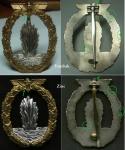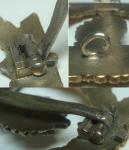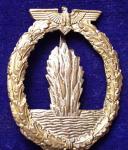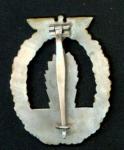-
Posts
162 -
Joined
-
Last visited
Content Type
Profiles
Forums
Blogs
Gallery
Events
Store
Everything posted by Norm F
-
Very interesting topic, Justin, and worthy of it's own thread. I too am amazed at the "value" of certain items. It's clear that the number of examples of an item originally produced does not always correlate with market value -- indeed often it's totally irrelevant. Sure oakleaves or minesweepers with diamonds, etc. are rare items, but the vast majority of KM items in trade were produced in abundance and the value is a virtual concept based on popularity, subject to the emotional breezes on the world-wibe web. We've talked before about how gold-coloured KM belt buckles produced in huge numbers go for ridiculously high prices compared with Heer and Luftwaffe buckles just because they're pretty and people covet and hoard them. Many rare things from earlier times, Weimar or Imperial, go for peanuts simply because there's not a current fad surrounding these items. On the Antique Road Show you hear experts talk about certain items, furniture, pottery, etc. and how they were worth more at certain times in the past when they're popularity was at it's height. Currently, WW2 has just the right combination of antiquity, yet immediacy with family ties, and drama and controversy to give the appeal to a wide range of collectors. I think it's possibly at it's peak of interest and it's conceivable this will fade over time as WW2 recedes into the past like WW1 and earlier pan-European wars. Meanwhile I'd wager that DDR items that currently are a dime a dozen will become much more valuable 40 years from now when people look back to what will seem a fascinating era of history with Germany being divided between east and west and the whole mystique of communist secrecy around East Germany. I think few collectors think in terms of investment and view their collections like a real estate or stock market investment - we're interested in the history of an item and the human stories around it. The "salty" items evoke a sense of the hardships of wartime experience and the mint items are like time machines giving us a view of how they looked to recipients at the time. There you go. Some musings for the New Year! Best regards, ---Norm
-
Hi Laurens, As far as I know, all the Imperial Navy Torpedoboote were unnamed - they had numbers only. The Torpedoboot Wolf was laid down, launched and commissioned in 1927-28 during the Reichsmarine era. http://www.german-navy.de/kriegsmarine/ships/torpedoboats/torpedoboot1924/wolf/index.html Yes, Justin was referring to Gordon's pinned thread. To distinguish Imperial from Reichsmarine tallies it's best to look at the history of the named ship or unit. Best regards, ---Norm
-

Kriegsmarine Unmarked Minesweeper
Norm F replied to Norm F's topic in Germany: Third Reich: Wehrmacht Medals, Decorations & Awards
For good measure, notice here the remarkable similarity between the hardware of the unmarked zinc Juncker-style Minesweeper and a maker-marked zinc Juncker Coastal Artillery badge. I think that almost clinches it. Best regards, ---Norm -

Kriegsmarine Unmarked Minesweeper
Norm F replied to Norm F's topic in Germany: Third Reich: Wehrmacht Medals, Decorations & Awards
Now another Juncker connection! Here you see a comparison photo between my tombak in the top row and a photo of a zinc badge below that exhibits all the typical features identifying it as the same maker as our tombak versions: double-breasted eagle, slightly splayed eagle legs, the bevel on the left tip of the swastika, and the typical margins on the reverse. And now the hardware on the reverse of the zinc badge is typical for other Juncker-made badges, including a hinge similar to that seen on the Juncker-style U-boots and interestingly a flat-wire catch, seen not only on other Junker badges, but also on the variant minesweeper posted in this thread. So there you have it -- both the early tombak and later zinc versions of this variety of minesweeper exhibit hardware typical for a range of Juncker-made badges. Best regards, ---Norm -

Kriegsmarine Unmarked Minesweeper
Norm F replied to Norm F's topic in Germany: Third Reich: Wehrmacht Medals, Decorations & Awards
Now note typical features of the reverse contour of these badges. 1) deep shoulder cutouts as shown by the green arrows 2) the typical deep edge cutouts making almost 90 degree angles. 3) the short, acute-angled lower portion of the water spout. Although other maker's MS badges may show one of these features, I've found that the constellation of all of these features is typical only for this maker. -

Kriegsmarine Unmarked Minesweeper
Norm F replied to Norm F's topic in Germany: Third Reich: Wehrmacht Medals, Decorations & Awards
I think the next few slides may be the "pièces de résistance". In preparation, note the features of the eagles on these tombak Juncker-style minesweepers: 1) "double-breasted" eagles 2) slight splaying of the legs 3) occasionally seen with a variable amount of bevelling on the left tip of the swastika (mine is the first in the upper row) -
So I now believe this badge was made by the same maker as the so-called "Juncker-style" minesweepers, if not actually by Juncker; one could speculate it was from a later batch that was mis-stamped and a later flat-wire catch applied. On the other hand depending on which you think came first, round wire catches or flat-wire catches, maybe it was an earlier run that they hadn't quite got right. Please note that my analysis as posted is based on seeing only this one photo example of the smooth-bordered Minesweeper with a flat-wire catch. I'd be interested if anyone has other examples, or opinions on this topic. Best regards, ---Norm Edit: The discovery of a zinc "Juncker-style" minesweeper with the flat-wire catch now indicates that the flat-wire catches were later than the round-wire catches, and suggests that this round-edged tombak was a transitional late tombak batch, combining the earlier block hinge and dome-head hinge pin with the later flat-wire catch.
-
As it turns out, I now believe this badge fits into the discussion on the "Juncker-style minesweepers" I posted here. Don Doering at WAF made the observation that the smooth edges result from a failure to remove the flashing around the wreath in the die stamping/forging process. I then looked more closely at the features of these photos, comparing them to the "Juncker-style" minesweepers. Looking at the composite attached below, several correlations are noted: 1) similar hinge blocks with dome-head hinge pins (not commonly used by other MS makers) 2) similarities seen in the reverse - namely, the cutout eagle shoulders (marked with green arrows) and the short acute-angled lower portion of the water plume (circled in the photo below). Whereas other makers may look similar in either one of these area, the combination of the two features I see only in the so-called "Juncker-style" minesweepers. 3) the flat-wire catch on this smooth-bordered MS is similar to those seen on other marked Juncker badges, and also in unmarked "Juncker-style" U-boot badges. Best regards, ---Norm
-

Kriegsmarine Unmarked Minesweeper
Norm F replied to Norm F's topic in Germany: Third Reich: Wehrmacht Medals, Decorations & Awards
So as you can see from the previous posts, the similarity of our unknown maker's hardware to Juncker hardware forms the basis of naming these badges "Juncker-style minesweepers". The dome-head hinge pins certainly suggest a Berlin connection, having been used extensively in early Schwerin tombak badges. I'd be interested in other opinions and any ensuing discussion. Best regards, ---Norm -

Kriegsmarine Unmarked Minesweeper
Norm F replied to Norm F's topic in Germany: Third Reich: Wehrmacht Medals, Decorations & Awards
Now, here is a composite of round wire catches from a variety of different maker-marked Juncker badges for comparison. All are on tombak badges. The similarity to the catches on our unknown maker's tombak minesweepers is apparent. -

Kriegsmarine Unmarked Minesweeper
Norm F replied to Norm F's topic in Germany: Third Reich: Wehrmacht Medals, Decorations & Awards
Now we turn to the round wire catches. Here is a composite of several examples of these catches from our unknown minesweeper maker. Mine is the first in the top row. -

Kriegsmarine Unmarked Minesweeper
Norm F replied to Norm F's topic in Germany: Third Reich: Wehrmacht Medals, Decorations & Awards
Although Juncker used a variety of different hinges on various badges, most of which differ from these, here is one in particular on a marked Juncker Coastal Artillery badge (interestingly another KM badge) that bears a striking resemblance to our minesweeper hinges, including the dome-head hinge pin. -

Kriegsmarine Unmarked Minesweeper
Norm F replied to Norm F's topic in Germany: Third Reich: Wehrmacht Medals, Decorations & Awards
Now, concentrating on the hinge block. Here is a collage of hingeblocks from various examples of this unknown maker's minesweepers. Mine is the large one on the left and again in the beginning of the top row. Most, but not all, have the dome-head hinge pins, similar to those used by Schwerin and Juncker in Berlin. -

Kriegsmarine Unmarked Minesweeper
Norm F replied to Norm F's topic in Germany: Third Reich: Wehrmacht Medals, Decorations & Awards
Since I received my new badge, I've done some comparisons and posted some observations on another forum. I'd like to post here as well to complete this thread and garner further discussion if I may. The original question was could these badges have been produced by Juncker. My understanding is Martin has done similar comparisons in the past and considers it quite likely. First off, here is a closeup of the hardware on my unmarked minesweeper. -
Hello all, RichardT from WAF and on GMIC as well has allowed me to repost these photos for discussion. This is another variety of unmarked Minesweeper which I hadn't seen before but of which Richard has seen photos of several examples. It's quite unusual in that on the reverse you can see completely smooth margins as marked in the photo. The eagle on this example looks a little rough to my eye. Aside from these unusual features I was intrigued by the hinge and dome-headed hinge pin. So far I have seen dome-headed hinge pins only on the tombak unmarked minesweeper discussed in the previous thread, http://gmic.co.uk/in...showtopic=40890 and also in Schwerin early tombak badges. So my questions about this badge are: 1) Is this recognized as a period maker, even if identity is unknown? 2) Are they always tombac, and if so are they thought to be early production? Perhaps before switching to a different more detailed die leading to another recognized variety? 3) Given the scarcity of makers using dome-headed hinge pins, could there be a connection either geographically or in a business sense between Schwerin, this maker and the other maker of unmarked badges mentioned earlier? I'd welcome any thoughts and comments. Best regards, ---Norm
-
Just to make sure I understand, is the photo you marked with the red arrows a photo of a reproduction and it's that tiny gap that distinguishes it? The original in the next post is a much smaller view but I take it there's no gap there, correct? (Just wasn't sure I was seeing it.) What about the fact that in your original the areas between the eagle's head and the shoulders of the wings is not cut out whereas it is in the first two pictured shields? Is that significant or does that vary with manufacturer? Best regards, ---Norm
-

Kriegsmarine Unmarked Minesweeper
Norm F replied to Norm F's topic in Germany: Third Reich: Wehrmacht Medals, Decorations & Awards
Thanks again Martin. And thanks Nesredep. Once I get the badge in hand I'll post more photos. Although I see the resemblance to Juncker hardware I also see differences so I'm looking forward to posting some closeups of the hardware. As well, I'm intrigued by the large headed pin in the hinge characteristic of these minesweepers which is not seen on any marked Juncker badges. In fact the only other hinges I've seen with such large-headed pins are on Schwerin badges. Pictures to follow eventually to facilitate discussion. Best regards, ---Norm -

Kriegsmarine Unmarked Minesweeper
Norm F replied to Norm F's topic in Germany: Third Reich: Wehrmacht Medals, Decorations & Awards
Thanks very much Gordon. I'm quite happy to be getting this badge. I'm still looking forward to the release of your book on KM badges. I guess not in time for Christmas! Best regards, ---Norm -

Kriegsmarine Unmarked Minesweeper
Norm F replied to Norm F's topic in Germany: Third Reich: Wehrmacht Medals, Decorations & Awards
-

Kriegsmarine Unmarked Minesweeper
Norm F replied to Norm F's topic in Germany: Third Reich: Wehrmacht Medals, Decorations & Awards
-
Hello all, I was hoping for some opinions on this badge which I have on hold. I think it is a mint tombak unmarked minesweeper of the same type as has been posted before, by some thought to be Juncker based on the reverse setup (but not proven). This certainly matches that type, but my question is have there ever been copies of this type and does this look genuine to more experienced eyes? The only thing that stuck out in my eye was the odd bevel to the tip of the left side of the swastika which I haven't seen before. Best regards, ---Norm

















